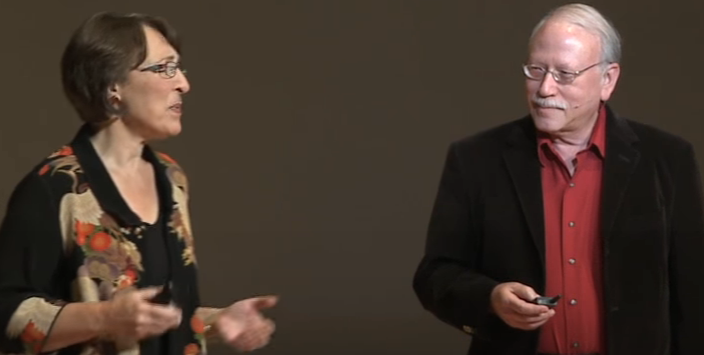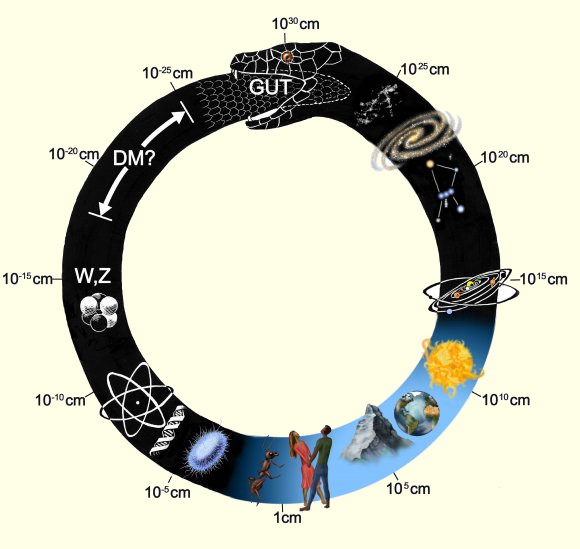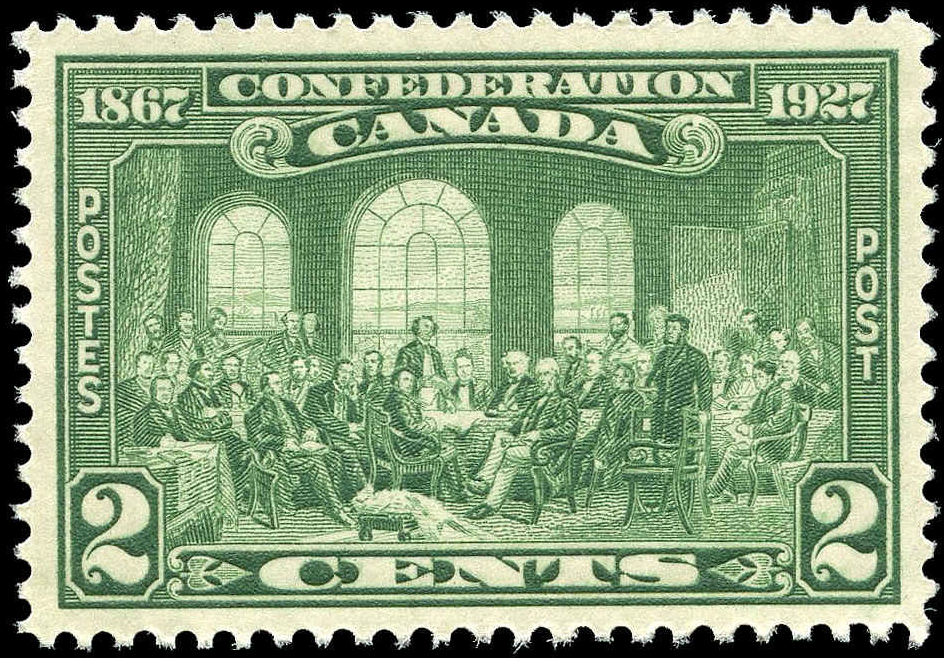
|
|
Voyage to a cosmic perspective 1 The Uroboros in a 15th-century alchemical tract, a snake biting its tail, The oldest image of the Uroboros has been found in the "Enigmatic Book of the Netherworld," an ancient Egyptian funerary text from the 14th century BCE, in the tomb of Tutankhamun; and also in other Egyptian sources where, like many Egyptian serpent deities, it represents the formless disorder that surrounds the orderly world and is involved in the world's periodic renewal. It is also perceived as symbolic of the cyclical nature of the year. Alchemists linked it to the Lapis Philosophorum, the philosophers' stone they hoped could turn mercury ino gold or allow periodic rejuvenation to achieve immortality. The skin-sloughing process of snakes symbolizes the transmigration of souls. In Gnosticism, it symbolyses eternity and the soul of the world. The tail of the snake is a phallic symbol, the mouth is a yonic or womb-like symbol. The Jungian psychologist Erich Neumann writes of it as a representation of the pre-ego "dawn state", depicting the undifferentiated infancy experience of both mankind and the individual child. And so it goes. 3 Laugh it off if you will, but the Uroboros stimulated the German chemist August Kekulé, to come up with a major insight: that the benzene molecule, C6H6, has a ring structure. Quoting: The Uroboros caught my attention only a week or so ago when I came to page 30 of "The New Universe and the Human Future: How a Shared Cosmology Could Transform the World" (2011) by Nancy Ellen Abrams and Joel R. Primack. The book's subtitle put me off at first, but then I found that it was published by Yale University Press and that the authors have incredible CVs, academic and public service. Since then I came across a similar image when viewing a 2005 talk by British Royal Astronomer Lord Martin Rees who, like Abrams and Primack, attributed huge significance to the place of humans in this perceived cycle.* 5 At this point let's first get a grasp of those measurements, consistently shown in centimeters. Those are the sizes of the objects shown. The size of atoms falls pretty well in the range of 3 × 10-10 to 3 × 10-9 cm. Our Sun's diameter is 1.4 million km, which is 1.4 × 1011 cm. Our Sun is one of hundreds of billions of stars in a disk-shaped galaxy that we call the "Milky Way," the long diameter of which is 52,850 light years, equal to 5 × 1022 cm. The Big Bang happened 13.8 billion years ago. The speed of light being 3.00 × 1010 cm/sec, this corresponds to a distance travelled of 3.9 × 1025 cm. As for Dark Matter, whatever it is, it does not radiate nor does it reflect light. We are assured it exists by trusting the mathematical wizardry of our physical astronomers to account for its gravity; and that still leaves us with a question mark about size. 7 Next step: Let's look at this same picture differently. On the right side, from the Sun up, we we see astronomically big numbers for objects in the domain of astronomy. Physics, notably Einstein's General Theory of Relativity, published in 1919, provides scientists with a toolkit filled to the brim with theories. In 1968, NASA put the first astronomical observatory in space. Others followed, greatly expanding our view of what is out there. 8 The picture's blue segment, referred to as "Midgard," is the world of our common experience: solid, observable things connected by gravity. Our Earth is a planet in the solar system, which is one of billions of stars in the Milky Way. It is one of three major galaxies plus some 40 others that make up a cluster of galaxies, which, guess what, is part of a super-cluster, all attracting one another by gravity. There are other super-clusters aplenty, but whatever gravity binds a super-cluster to an other super-cluster is overridden by something called "Dark Force." We are given to know that the Dark Force expands the space where it exists while producing still more of itself. An outcome is that it looks to our observers that super-clusters repel one another at an accelerating rate. All in all, and as far as we know, our cosmos is expanding ad infinitum 9 On the left-hand side of the picture, from atoms upward, observable and surmized objects get smaller and behave in one of two different ways. Observing them is like the flipping of a coin; they either act like particles or like waves—think of microwaves, for example. This duplicity is the subject of quantum physics. 10 Einstein didn't like quantum physics one bit—"God does not play with dice!" And so it seemed that either God or the dice had to go. Quantum theory held sway, while God tenaciously is still hanging in there even though the way people perceive Him is achanging. The Holy Grail of physics today is to come up with a theory that makes relativity theory compatible with quantum theory. We already have a name for it: "Grand Unified Theory." Until that comes about may mutual tolerance between God and dice prevail and allow one and all to enjoy the Christmas season. 11 A lot has happened from the instant of the Big Bang. It took 130,000 years, an insignificantly short time compared to the 13.8 billion years from then till now, before atoms of hydrogen, helium, and lithium came into existence. The first stars formed from clouds of gas around 150–200 million years after the Big Bang. Heavier atoms such as carbon, oxygen and iron, have since been continuously produced in the hearts of stars and catapulted throughout the universe in spectacular stellar explosions called supernovae, which themselves became part of subsequent generations of stars that, in turn, further added to the variety of atoms such as we have here on Earth. All of this brought about an increasing complexity of substances from which life and eventually humans formed. We are the most complex things formed since the Big Bang. 12 It was 130,000 years after the Big Bang that our freshly minted universe began radiating a variety of photons, with those of visible light among them, all travelling at the same speed, 300,000 km/sec:  Spectrum of photons: The electromagnetic spectrum (left to right: decreasing frequency, increasing wavelength). Direct and reflected stellar radiation made a fragment of the cosmos's atomic content observable by Earthlings. As for dark matter, it neither gives off nor interacts with any kind of electromagnetic radiation in our astronomers' toolkit. 13 When light travels through expanding space, wavelengths stretch out which for visible light is perceived as a change in color, the so-called "red shift." That is what tried-and-true science tells us. Facts lead to speculation, hypotheses. When a hypothis leads to predictions that later turn out to be correct then we have a theory that scientists assume gets us closer to the cosmic truth. As far as the universe goes, it is a voyage through facts to hypotheses to correctly predicting additional facts to hypotheses, and so on, that Abrams and Primack are making in their 2011 book and Lord Rees is outlining in numerous video clips on the internet, almost right up to the present.* 14 Let's go back to Lord Rees's "Is this our final century?" and that picture of the Uroboros. I think this is worth quoting:  The Cosmic Density Pyramid found in Abrams's and Primack's book. Looks familar? Have a peek at a U.S. one-dollar bill. The new order came about by the insights scientists gained notably with our orbiting observatories. This imaginative pyramid catalogues stuff in our shared cosmos. Notice that only a tiny fragment of the cosmos's content became observable by Earthlings. How little we know, even with our cosmic perspective. 16 I am for all practical purposes an atheist, but not altogther. There is a bit of agnosticism in me that challenges the atheist me to prove that an all-knowing, all-controlling deity does not exist. Consider the probability that a higher-dimensional universe coexist with our four-dimensional cosmos (length, width, height, and time). We can't see it because we are limited by our own dimensions, but there is that possibility that we can be observed and even be manipulated from outside our cosmic bailiwick. Voilà! Ridiculous, you think? Well, try to convince England's Astonomer Royal, Baron Martin John Rees of Ludlow, OM, FRS, FREng, FMedSci, FRAS about that. Or the authors of "The New Universe and the Human Future." You see, whatever banged the Big Bang we talked about may well have banged many times. We simply don't know. 17 For a long time, our thinking ancestors pictured themselves living on a flat earth. But then that picture changed when measurements began to show that our Earth is a globe which was first thought of being at the center of the universe, a picture reinforced notably by the creation story as found in the Bible. Christian doctrine, for one, made thinking otherwise punishable by torture and death. But as the insight took hold that our Sun is the center of the universe, and later still the Sun lost its pride of place, Christian faith became more tolerant. Bring on the fourth dimension, that of time, a cosmic view places us again at the center, but not of a space this time, but of a past. No matter whatever direction you look, it took time for light to travel from what you see to your brain. Our universe is a sphere of time gone by. The sunlight we see has travelled 8.3 minutes to get here. The light from the North Star has travelled 680 years to get here. We are the center of a past going back to the Big Bang, 13.8 billion years ago. Again: we are not at a center of space, but at a center of time. Abrams and Primack refer to this center as "a symbolic, meaningful place, created by the interaction of space, time, light, and consciousness. Without consciousness, after all, there would be no visible universe." 18 Quoting from their book: * * *
 Elisabeth ("Mam") turned 93 on August 30. She was born far, far away: about 8.8 × 1014 or 880 trillion km away or 22 times the distance to the nearest star, alpha-Centauri. (Snapshot by Evelyn van Eyken-Zauner. Bouquet from me.) 20 In 1976, co-author Nancy Abrams and colleagues were assigned to assess the USA's long-term science and technology needs with an eye on global warming, dwindling supply of cheap oil, and the cost of health care, The longest time ever considered was 30 years. She wasn't exactly the first to come to that conclusion. In the weekly The Elzevir Library of May 8, 1884 published "What Knowledge is of Most Worth" by philosopher Herbert Spencer who concluded: Abrams developed a method for ferreting out underlying scientific questions in controversial political or moral issues. In the 1970s and "80s, a big question was whether or not bingeing on carbon-based energy sources should be offset by nuclear power. Or putting it differently, global temperature rise vis-à-vis nuclear danger and expense. Bring together people with opposing views and then, with the help of a mediator, have them jointly write a paper advising a government agency or a court. The method is kown as scientific mediation." It does not decide; it merely helps getting rid of personal biases among those arguing to ensure that the technical issue at stake is clearcut. The method proved successful in getting opposing sides to agree on whether a Swedish utilities' plan for nuclear waste disposal was deemed adequate. 23  Nancy Ellen Abrams and Joel R. Primack talking about "Changing The World Through A Shared Cosmology." (TED, 2011.) 24 It is evident that the Adams-Primack couple and Lord Rees agree on a need for a cosmic perspective for dealing with current threats to the very existence of human beings. Also evident, to my mind, is that there is a strong disagreement on how far back that perspective should go: 13.8 billion years to the Big Bang or about five million years to the demise of our planet. And no unbiased mediator assigned to help out. 25 Off hand it first seemed to me that Adams and Primack are taking things too far, but then, taking a further look, another factor came into play. That other factor is an origin story to be shared by the entire global population. Incredible? But think of it: religious believes include creation stories, nations have origin stories; stories cobbled together from selected pieces of history and myth, decorated with attire, flags, hymns, anthems, processions, parades, what-have-you. Conflicting stories begetting conflicts .... Why do we have those stories? Necessity? Why, then, not try to make a clean sweep with an origin story that fits all, right around the globe? 26 Commonality binds people together, entices sympathy, fertilizes cooperation. Distinct commonalities keeps groups of people apart, breeds strife, competition, armed conflict. Languages are a class of distinct commonalities that cause misunderstanding, hence on to suspicion and distrust. The idealist Ludwik Lejzer Zamenhof offered humanity a carefully designed universal auxiliary language, Esperanto, but clearly, it has failed to cement a worldwide brotherhood, thus far. One obstacle: language is only part of what we loosely call "cultures." More binding is needed, but in short supply. Tolerance? Helps a bit, but it is a fickle thing, easily swarthed by fear. 28 A common origin story should provide a hefty dose of glue, so hefty that when history falls short, myth should fill the gap. Canada has two anthems sung to one tune. In one version we find, "Our home and native land," in the other, "Terre de nos aïeux." Even though, according to the 2016 Census, 7,540,830 people, that is, 21.9% of the Canadian population, were foreign-born, to say nothing of our Innuit and native Indians. However we do have an ancestral land that we share with everybody, our Earth. In fact, we have an origin shared by everything in the visible and invisible universe, a spark that set off the Big Bang. 29 Old, well-established notions die hard. One such a notion is that our Earth is an average planet of an average star. The book tells us that considerable evidence is building that this is simply not so, that our planet with all that is on it—notably intelligent life— is something special in our universe, possibly unique! 30 Like people thinking that the human-driven extinction of wildlife is a crime our offspring will not ever forgive us for, so do Adam and Primack believe that a human-driven end to life, intelligence especially, is a cosmic crime. Our origin story, they feel, must include a moral imperative, An origin story does need to speak to our feelings and imagination, It should be colorful and easily understood. Genesis, I believe, fills the bill: Going in a direction Abrams and Primack are pointing, allow me a try:
How small a first step for man in a voyage to a global perspective .... May it serve us well. 34
Footnotes German chemists Joseph Loschmidt (in 1861) and August Kekulé von Stradonitz (in 1866) independently proposed a cyclic arrangement of six carbons with alternating single and double bonds.Ref. * fn1 "Is this our final century?" * fn2 One source for considerable detail about the Big Bang: Wikipedia To be sure, The Big Bang theory is a cosmological model of the observable universe from the earliest known periods through its subsequent large-scale evolution. Not all astrophysicists are altogether happy with it. Other models exist. * fn3 |
--
| top of page |
|
 "I was sitting, writing at my text-book; but the work did not progress; my thoughts were elsewhere. I turned my chair to the fire and dozed. Again the atoms were gamboling before my eyes. This time the smaller groups kept modestly in the background. My mental eye, rendered more acute by the repeated visions of the kind, could now distinguish larger structures of manifold conformation: long rows, sometimes more closely fitted together; all twining and twisting in snake-like motion. But look! What was that? One of the snakes had seized hold of its own tail, and the form whirled mockingly before my eyes. As if by a flash of lightning I awoke; and this time also I spent the rest of the night in working out the consequences of the hypothesis."
"I was sitting, writing at my text-book; but the work did not progress; my thoughts were elsewhere. I turned my chair to the fire and dozed. Again the atoms were gamboling before my eyes. This time the smaller groups kept modestly in the background. My mental eye, rendered more acute by the repeated visions of the kind, could now distinguish larger structures of manifold conformation: long rows, sometimes more closely fitted together; all twining and twisting in snake-like motion. But look! What was that? One of the snakes had seized hold of its own tail, and the form whirled mockingly before my eyes. As if by a flash of lightning I awoke; and this time also I spent the rest of the night in working out the consequences of the hypothesis."
